|
In the Land of the Gods
Exploring India’s Buddhist Heritage
By Volker Poelzl
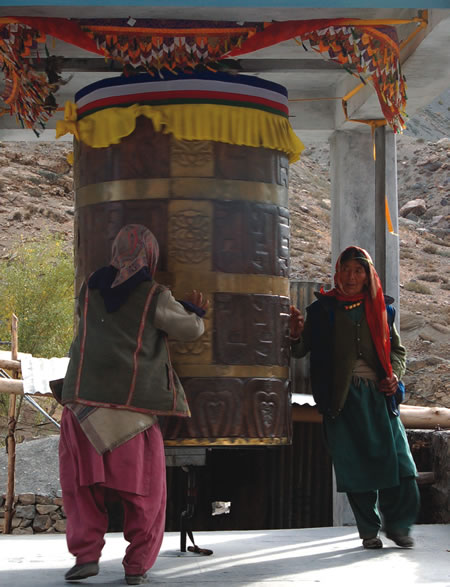
|
A large Buddhist prayer wheel in a village in Spiti Valley.
Photo ©Volker Poelzl.
|
Northern India is a fascinating place to visit. The snow-covered Himalayan Mountains rise to towering heights here, and the landscape varies from dense forests and fertile plains to high desert valleys. The region’s
ancient name “Dev Bhumi,” which means “Land of the Gods,” is no misnomer. The grandeur of the towering peaks, glaciers, and vast valleys is so breathtaking that it was considered the abode of the gods in ancient India.
A Land of Snow and Ancient Traditions
It is in the northern part of this mountainous region, in the cold deserts along the Indian-Tibet border, where India’s oldest Buddhist traditions survive. Buddhism first emerged in India in the sixth century B.C.,
but it gradually succumbed to the advances of Islam and has disappeared as a major religion in India today. Spiti Valley, located in India’s Himachal Pradesh state, is a notable exception. Buddhism was first introduced there in the tenth
century A.D. and has remained the region’s predominant cultural and spiritual influence. This makes Spiti Valley a great destination to experience India’s Buddhist heritage as it is practiced today.
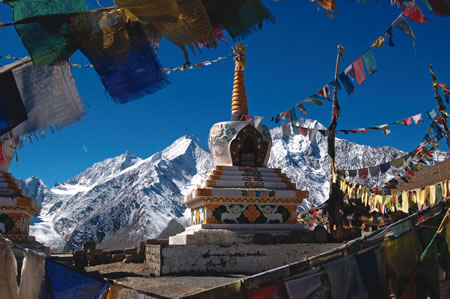
|
Kunzam Pass is adorned with stupas and prayer flag.
Photo ©Volker Poelzl.
|
With its long-standing Buddhist traditions, it is not surprising that the Dalai Lama took refuge in Himachal Pradesh state after the Chinese invasion of Tibet in 1959. But while the Dalai Lama’s headquarters in Dharamsala,
in the western part of the state, is popular with foreign travelers, Spiti Valley, in the eastern rain shadow of the Great Himalayan range, remains a remote and little visited region. It is sparsely populated, and human presence is only noticeable
in the form of small villages and scattered monasteries. The rapid development going on elsewhere in India is not noticeable here, and the barren valley remains distant from the hustle and bustle present in much of India.
Although roads are precariously maintained and access is somewhat an adventure, a visit to Spiti Valley is worth every effort. No matter which direction you come from, a spectacular sight awaits the traveler arriving in
Spiti Valley. A narrow blue river meanders across the valley, providing a stark contrast to the snow-capped peaks and barren, rocky slopes. “Himachal” means “land of snow,” and part of the state, especially Spiti Valley,
is largely cut off from the outside world during the long winters. This geographic isolation explains why the region has a unique cultural and ethnic identity. The local inhabitants are mostly ethnic Tibetans with a culture, language, and traditions
that are different from the rest of India.
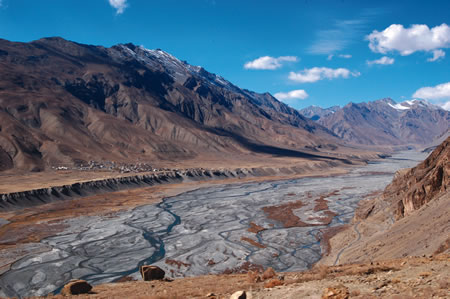
|
A view of Spiti Valley.
Photo ©Volker Poelzl.
|
It is immediately noticeable upon arrival in Spiti Valley that Buddhism is not only practiced at the temples and monasteries. Most aspects of daily life are infused with Buddhist symbols and rituals. “Stupas” or “chortens,” which
are Buddhist monuments, are scattered across the dry landscape, and colorful “lungtas,” Tibetan prayer flags, fly from rooftops, flagpoles, and mountain passes. The Buddhist mantra “om mani padme hum” can be found written
on rocks and entire mountainsides. This mantra is a harbinger of good luck and a reminder of the Buddha’s teachings. “Mani” prayer walls, built with stones that have mantras carved on them, are often found in villages and along
roads. They are also said to bring good luck, and pedestrians and drivers always go around them in a clockwise fashion. Many villages have a large prayer wheel in a public place, which passersby spin clockwise, while repeating a mantra. In this
barren valley of rock and snow these Buddhist symbols seem to be an attempt to humanize an otherwise hostile landscape. The locals pay deep respect to the symbols of their religion and gain hope and spiritual strength from the rituals associated
with them.
Despite the difficult living conditions and the harsh climate, the locals are friendly and helpful, and travelers are always welcome. To my great surprise I found that many people not only speak their local dialect and Hindi,
but they are also fluent in English, which makes it especially easy for travelers to get around.
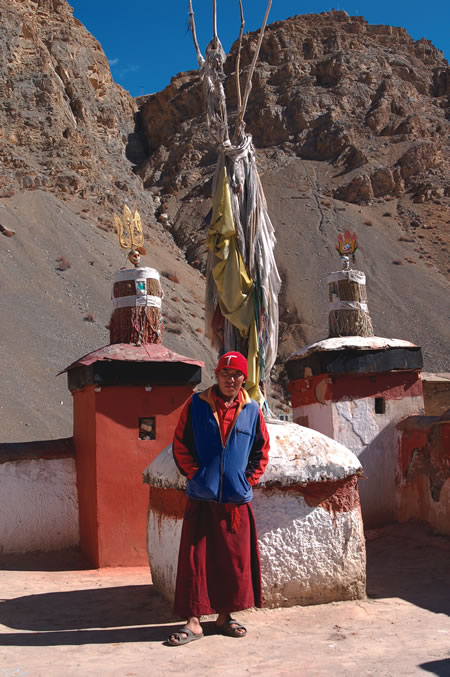
|
A Buddhist monk at Ki monastery.
Photo ©Volker Poelzl.
|
Exploring Spiti Valley
Among the highlights of visiting Spiti Valley are the thirty Buddhist monasteries scattered across the valley and adjacent mountains. The monks are genuinely friendly and visitors are always welcome. There are usually several
English-speaking monks who guide visitors through the monastery complex and show them temples, shrines, and other cultural treasures. Expect to be invited for a cup of tea and a chat at the end of your visit. For those interested in Buddhist
items, some monasteries sell prayer bells, prayer flags, “thangkas” (embroidered images of the Buddha), and devotional silk scarves known as “kata.” You may also be able to purchase incense sticks and “mala” prayer
beads, which helps the population of resident monks. Donations are always welcome, too.
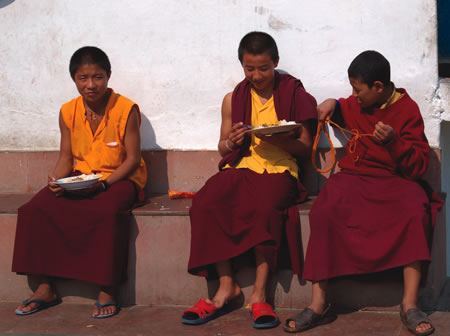
|
Young Buddhist monks enjoying lunch.
Photo ©Volker Poelzl.
|
The monastery at Tabo, founded in 996 A.D., is the oldest continually inhabited Buddhist monastery in India, and the impressive complex of nine temples houses magnificent statues of the Buddha and well-preserved murals.
I was told that His Holiness the Dalai Lama plans to retire there. Other outstanding monasteries in Spiti Valley are in Losar, Komic, Ki, Dhankar, Lha Lun, as well as Kungri and Mud in the nearby Pin valley, and Nako, in Hangrang valley. Each
of these monasteries has its own unique architecture, history, and cultural treasures. The Dhankar and Ki monasteries were built on rocky hilltops and resemble fortified castles, while the Tabo monastery was built close to the river in the valley.
Ki monastery has a rich collection of thangkas (silk paintings) and colorful murals, and Dhankar monastery is home to a valuable collection of Buddhist scriptures.
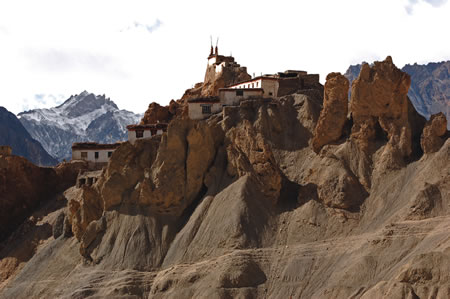
|
The Dhankar monastery.
Photo ©Volker Poelzl.
|
To explore the monasteries it is best to make the district capital your base. Kaza has basic tourist infrastructure with guesthouses, shops, and restaurants. Kaza is also the best place to hire a vehicle and driver for a
day or more, or to make arrangements for a trek or hike. Most monasteries have a guesthouse, where visitors are allowed to stay. Spending a night at a monastery is a great way to share the lives of the monks and learn about their faith and religious
practices. Several villages, such as Dhankar and Komic, also offer homestays, where visitors can spend the night with a local family in a traditional Spiti house, savor the food and experience the traditional local lifestyle. Several other villages
have government rest houses, where travelers can spend the night.
For visitors interested in trekking, there is a 5- to 7-day trek through the highlands above the left bank of the Spiti river, which passes several monasteries and traditional villages. The trail also leads through the Kibber
Wildlife Sanctuary, which is home to snow leopards, Tibetan wolves, bharal (Himalayan blue sheep), and ibex, animals that are rare elsewhere. Treks can also be shortened, if you arrange to be picked up at one of the monasteries or villages along
the way. Alternatively, you can hire a taxi to take a daytrip to some of the monasteries in the mountains.
On a final note, travelers should keep in mind that the tourist infrastructure in Spiti Valley is rudimentary. There are few organized tours to the region. Travelers mostly depend on their own savvy to hire vehicles, find
accommodations, and plan their itineraries. But, on the other hand, the locals are very hospitable, and every meal you eat and every rupee you spend will directly benefit the local population and monastery residents. This makes individual travelers
a welcome boost for the local economy, in an isolated region otherwise dependent on staple crops and livestock.
|
For More Info
Travel Tips
There are two possible access routes to visit Spiti Valley:
Access from the South: To get to Spiti Valley from the south, you can take a plane, train, or bus from Delhi to the state capital Shimlah and continue by road to Spiti Valley, about 412 kilometers on a narrow, unpaved, and often precarious
mountain road. Although this is the longer and more tiring route, it allows you to visit several great destinations in Kinnaur valley on your way to Spiti Valley. Most hired and shared vehicles from Shimlah don’t travel all the
way to Spiti Valley because of the permanent danger of landslides at the southern entrance to Spiti Valley. There are daily buses that make the journey, but this option is not for the faint of heart. Unless you have little fear of heights
and consider yourself an adventurous traveler, it is best to access Spiti Valley from the north in a hired vehicle. To take the southern route you need an “Inner Line Permit,” since it passes through a restricted security
zone close to the strategically important border with China. To get a permit visit the District Magistrate’s office in Shimlah, bring three passport photos, and allow a few hours. If you are arriving in Spiti Valley from the north
and would like to continue south to Shimlah, you can get the permit at the Sub-Divisional Magistrate in Kaza. The permit is valid for two weeks.
Access from the North: If you prefer an organized tour or trek in Spiti Valley, or if you simply want shorter and safer access, the northern route is your best bet. You can fly from Delhi to Kullu in the central part
of Himachal Pradesh state and then take a bus or hired vehicle north to Manali, or you can take a bus from Delhi directly to Manali. In Manali you can find tour operators for jeep tours or treks in Spiti Valley. You can also hire a vehicle,
find a shared taxi or a bus that travels the 212 kilometers across Rohtang Pass (13,057 ft.) and Kunzam Pass (15,059 ft.) to Spiti Valley. This is a shorter route than from the south, and the road conditions are not as precarious. Vehicles
are rented by the day, and drivers usually know the monasteries, temples, and villages that are worth visiting. Keep in mind that Spiti Valley has an average elevation above 10,000 feet. To avoid altitude sickness, it is best to spend a
few days in Manali (6,725 ft.) or Shimlah (7,200 ft.), where you can gradually adjust to the altitude gain.
When to Go
The northern route to Spiti Valley from Manali is closed from November through May, due to snow on the passes. The best time to visit Spiti Valley is from June to October, when snow is unlikely. Starting in October,
the season winds down. Guesthouses, hotels, and restaurants close down, and there are fewer taxis that make the trip across the passes from Manali. Since Spiti Valley lies in the rain shadow of the Great Himalayan mountains, rainfall during
the monsoon season from July to September is rare. There are numerous fairs and Buddhist festivals celebrated in Spiti Valley, and they are a great opportunity to learn about local traditions and Buddhism in general. Among the best-known
events in Spiti Valley are: Losar Festival (Tibetan New Year), in February; Tsheshu Festival, in June/July; Kaza’s Ladarcha Fair, in August.
Online Resource
Himachal Pradesh Department of Tourism
|
Volker Poelzl is a living abroad contributing editor to Transitions Abroad. During this India trip he spent three weeks in the Himalayan region.
|
